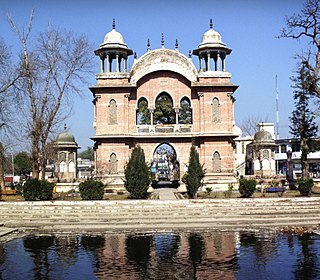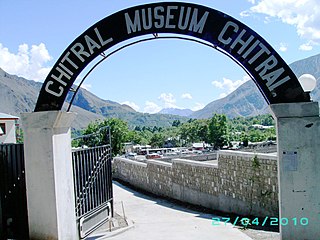
Khyber Pakhtunkhwa, often abbreviated as KPK or KP, is a province of Pakistan. It is located in the northwestern region of the country, along the Pakistan-Afghanistan border and close to Tajikistan border.

Peshawar, historically known as Purushapura, is the capital of the Pakistani province of Khyber Pakhtunkhwa and its largest city. It is the sixth-largest city in Pakistan, and the largest Pashtun-majority city in the country. Situated in the broad Valley of Peshawar east of the historic Khyber Pass, close to the border with Afghanistan, Peshawar's recorded history dates back to at least 539 BCE, making it the oldest city in Pakistan and one of the oldest cities in South Asia.

Charsadda District is a district in Peshawar Division of Khyber Pakhtunkhwa province in Pakistan. Prior to its establishment as a separate district in 1998, it was a tehsil within Peshawar District. Pashtuns make up majority of the population of the district. District headquarter is town of Charsadda, which was part of the Peshawar ex-metropolitan region.

Mardan District is a district in Mardan Division of Khyber Pakhtunkhwa province in Pakistan. The district is named after Mardan city, which is also the headquarters of the district. The district is famous for its agriculture industry, Peerah(پیڑا) the famous sooghaat of mardan and for its archaeological sites of Takht-i-Bhai, Jamal Garhi and Sawal Dher.

Mardān is a city in the Mardan District of Khyber Pakhtunkhwa Province, Pakistan. Located in the Valley of Peshawar, Mardan is the second-largest city of Khyber Pakhtunkhwa. It is a fast-growing city that experienced a population boom in the latter half of the twentieth century.

The Peshawar Museum is a museum located in Peshawar, capital of Pakistan's Khyber Pakhtunkhwa province. The Peshawar Museum is notable for its collection of Buddhist artwork dating from the ancient Gandhara region.

Gorkhatri is a public park in Peshawar, Pakistan, located within a Mughal-era caravanserai that was built at the site of ancient ruins.

Seri Bahlol, also Sahr-i Bahlol or Sahri Bahlol, is a city and archaeological site located near Takht-i-Bahi, in Mardan District, about 70 kilometer north-west of Peshawar, Khyber Pakhtunkhwa, Pakistan.

Ranigat is a collection of 2nd century CE Buddhist ruins spread over an area of 4 square kilometers which dates from the Gandhara civilization. Ranigat is located in valley Buner of Pakistan's Khyber Pakhtunkhwa province.
The following is a timeline of the history of the city of Peshawar, Khyber Pakhtunkhwa, Pakistan.

Swat Museum is a museum located in Mingora, on the Mingora and Saidu road in Swat District, province of Khyber Pakhtunkhwa, Pakistan.

Ihasan Ali is a Pakistani archaeologist. He served as Vice-Chancellor of Hazara University from 2006 to 2009 and Abdul Wali Khan University Mardan from 2009 to 2017. He has also served as Additional Vice-Chancellor of Islamia College University Peshawar. Dr. Ihsan Ali is a researcher, academic and administrator who has served in various fields. He is currently facing charges of making illegal staff appointments while he was leading Abdul Wali Khan University Mardan.

Hund Museum is an archaeology museum located in Hund, near the bank of the Indus River north of Attock, Swabi district, Khyber Pakhtunkhwa, Pakistan. It is frequented by thousands of visitors annually.
Dir Museum, also known as Chakdara Museum, is located in Chakdara, Lower Dir District, in the Khyber Pakhtunkhwa province of Pakistan. The museum offers a fine and unique collection of Gandharan Art.
Bannu Museum is a museum located in Bannu District, Khyber Pakhtunkhwa, Pakistan. The museum was established by the Directorate of Archaeology and Museums, Khyber Pakhtunkhwa and inaugurated in 2011 by Sayed Aqil Shah, Minister for Sports, Tourism, Archaeology, and Youth Affairs.
Mardan Museum is located in the Mardan District, Khyber Pakhtunkhwa, Pakistan. The museum was first established in 1991 in a Town Hall with a single hall with 22 show cases displaying more than 90 Gandhara's sculptures by the supervision of Sahibzada Riaz Noor. Later in 2006 a portion of land provided by the Mardan District Government on the request of Provincial Government and build three Galleries which was inaugurated by a former Chief Minister of Khyber Pakhtunkhwa Ameer Haider Khan Hoti in 2009.
Pushkalavati Museum also known as Charsadda Museum established in 2006, located in Charsadda, Khyber Pakhtunkhwa, Pakistan.

Chitral Museum is a museum located in Chitral District, Khyber Pakhtunkhwa, Pakistan, established on 8 July 2010.

Kalasha Dur Museum, also known as Bumburet Museum, is a museum located in Bumburet Valley, Lower Chitral District in the Khyber Pakhtunkhwa province of Pakistan. The museum houses a collection related to the culture and history of the Kalash people, as well as of the communities of the wider Hindu Kush area.














